Nathan vs His Game Collection: Day 10 - Dracula's Feng Shui
By theuselessgod 1 Comments
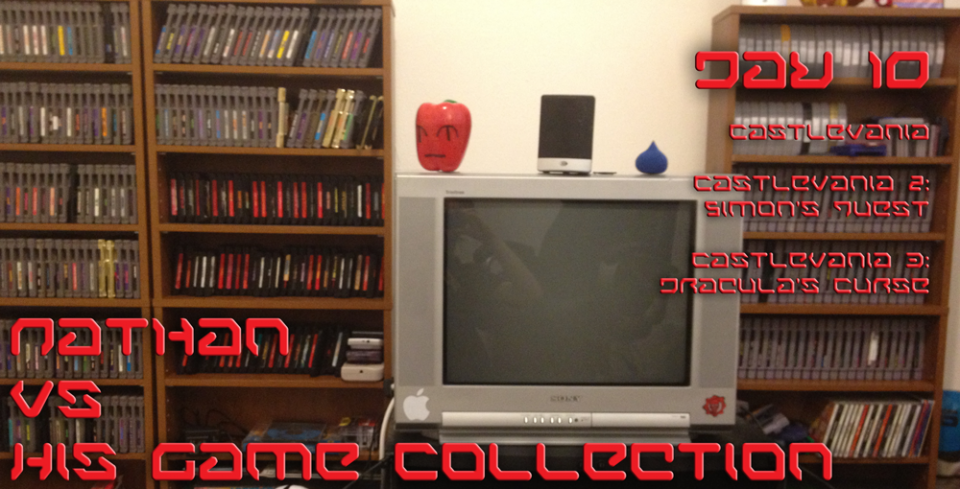
Today is all about one of my favorite game series: Castlevania.
CASTLEVANIA.
Aka "Suck it, Dracula, why won't you stay dead?"
I like Castlevania so much I even made a video of my Top 10 Castlevania songs. I guess that's the free youtube link of the day, even if Smooth McGroove's Bloody Tears acapella is pretty much the best ever.
Enough of my self-plugging of my defunct youtube channel (which I'll get back to after I learn Adobe Premiere...), let's hit up them reviews.
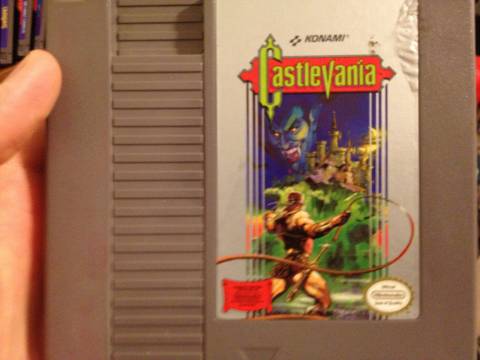
Castlevania
A little background
Castlevania, the first of Konami's blockbuster series (which has since taken some interesting turns), was released in the US in May 1987. It was meant to be a homage to all those old monster movies; you know, with bosses like the Mummy, Medusa, Frankenstein, and others. The movie motif was also evidenced by the film-reels that were on the sides of the title screen, an inclusion in every NES Castlevania title (this was later eliminated by the next gen games on the Genesis and SNES).
Something that has always impressed me about this first game (and later Bloodlines on the Genesis) was how much incredible work was put into every single step of the game. This was an era where game developers made grids and calculated exact jump distances, where every enemy's placement wasn't just there because they had an empty spot, but was placed in that specific location for a reason. Every single level, every single step in every single level was planned. These days, the only games that even come close to that level of meticulous design are perhaps the Dark/Demon Souls games, and even then I still imagine Castlevania was gone over more times than even those. It's Mario 3 levels of gameplay perfection, an art lost over the ages. This is gaming at it's perfect blend of art and geometry, every encounter calculated and played out exactly the way a developer wanted it. It's as much as argument for linear design as Call of Duty is an argument against.
Point? Castlevania is a crowning jewel of the NES. Few games of its time can reach its level, and even fewer games since. It's a bona fide masterpiece.
And I just did the conclusion before the review even started. Whoops.
First impressions last forever
This game's production values are extraordinary, especially the graphics and music. From the first scene as you approach the castle, I always just was marveling at how darned beautiful the freaking bricks on the outside of the castle were. Seriously, the bricks! They look so good! And the music, holy crap the music. Immortally remembered tunes. Man, this game's soundtrack, URRRRRRRR.
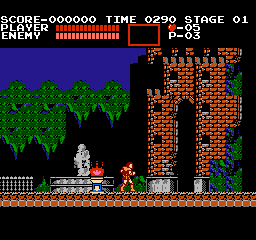
But as I played further...
Ok, gotta actually do impressions here. As stated by people more charismatic than I, there is a delay while you attack, which is annoying at first but quickly becomes a skill you develop. It requires you to think carefully when attacking, as there is both a delay before and after (and you can't attack while moving) which makes even the dumbest enemies a challenge. Remember when Bioshock came out and they made as if every splicer was some big battle, but eventually you just became Captain Lightning Hands and slaughtered 'em by the dozens? Ain't like that in Castlevania; game actually gets harder, and you don't get better (as a character. As a player, you actually learn skills to master the game).
Jumping is a major pain, but again; the game is designed around your awful, unalterable jumping arch. While technically it's "realistic" (since I can't change my direction mid-jump), it means every jump is a weird, floaty moon-jump. Which, again, takes some getting used to.
Also, this game is hard. While it is designed to give you the right powerups for areas, mastering those powerups (as well as whipping and jumping) is up to you. Again, with no actual character upgrades, this game relies completely on skill. And you'd better get skilled, or you'll never beat that hallway before Death (aka "The hardest part of the whole game.")
So what's the conclusion?
I recently read an article on GamesRadar where the writer was stating that retro games are starting to feel their age, and they aren't really comparable to modern games. To which I say "False, good sir! For one gander at Castlevania (or Mario 3. Or Shatterhand.) and you will find game design that matches even the best of modern attempts!"
Except I wouldn't actually say that because that would be weird and he can't hear me through the internet, but you get my point.
While many old games have sort of lost their edge as modern improvements make games more enjoyable, streamlined, and incentivized, games like Castlevania are still just as relevant as when they were released. Strong level design, controls, and windows dressing (graphics and music) hold up even to this day, and dare I say even outclass many modern games.
I'm just trying to say I really, really like Castlevania. Is that ok? Is that so wrong? Even if I ramble just a little bit, and use a few superlatives? I dunno, maybe you just saw the blocks of text and skipped to the end. That's ok to0.
If you own an NES, you should own Castlevania. Copies are going up in price (they're around $15-20 now), so grab 'em while the grabbing is good.
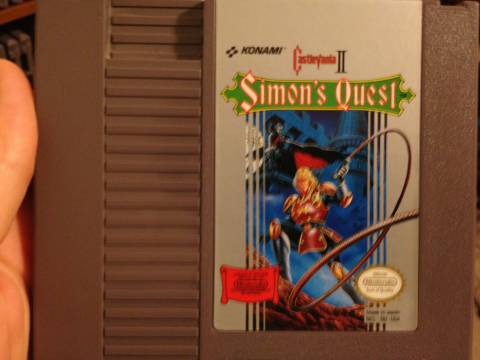
Castlevania II: Simon's Quest
A little background
Oh, poor Simon's Quest. This game just gets hated on by everybody. Released in December of 1988, it attempted to take the original Castlevania formula and ramp it up with a bigger world, more items and enemies, and a longer adventure that incorporated exploration and puzzle elements. Even a bit of RPGness was tossed in there, for good measure.
This game is often considered amongst games like Adventures of Link and Mario 2 as one of the "weird experimental sequels" of the NES era. Long before game developers were too scared to go completely crazy when making sequels to successful games, these three popular games all tried something unique with sequels to their blockbusters. And, while most people can at least agree that Adventures of Link and Mario 2 are ok (Mario 2 is awesome and I'll kill anyone who says otherwise), everybody universally hates Simon's Quest.
But is this hate really justified? Is the game that bad?
First impressions last forever
The game has a much darker color pallet than Castlevania, which makes everything look a bit muddy but also bleaker, which I kind of like. While going around town talking to people feels useless (and I fell in the river. Oops), it's still kind of a cool concept. And the music is still quite good, if not as good as the original.
I'd also like to go on a tangent here. The first time you step out of the town into the forest, and see the 8-bit trees leading off into dense thickets, the wolves and skeletons coming for you, and that killer Bloody Tears kicks in, I'm always overcome with a sense of...something. Like I'm going off into this amazing new world, full of adventure and mystery.
See, that's something I feel is lost in modern games. Advances in technology let us render every single leaf on every single tree, making the game more real than ever before. But something about seeing everything ruins a bit of the magic, and takes away the mystery. Stepping out into Castlevania 2's world for the first time evokes a sense of starting on a grand adventure, like Bilbo when he left the Shire for the first time in The Hobbit. We don't know what's out there, where Castlevania 2 is going to take us, but man are we excited for it!
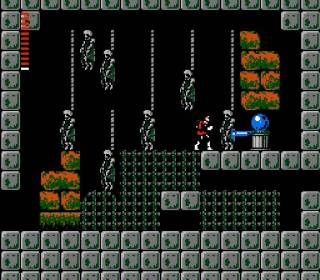
But as I played further...
Too bad that excitement is ill-founded.
Castlevania 2's biggest problem is lack of direction, not just on the player end, but on the design side as well. Playing through, whippin' dudes is fun for the first bit, until you realize you have no idea what you are doing. You don't know what your goal is, where you should be going, and what you should spend your hearts on. Eventually you go too far for your current gear and get killed by some overpowered enemies, losing all your hearts and starting over. This is standard for a first-time playthrough without a guide, and unlike in Castlevania where deaths were your own fault, this is unfair and the fault of the game's design.
So you start off again, staying within the carefully restricted playground Castlevania 2 allows you to wander with your current toolsets. You become scared to explore this world, because death's penalty (losing all your hearts) is extremely harsh. You stop being excited to see the world, and instead feel like you're being kept in a playpen while the rest of the world is out having fun. It's maddening.
And then, once you farm enough hearts to get the gear needed for the next area, you don't feel accomplished. You moved from one prison to another, farming more hearts for the next area. Great.
I don't think the ideas here are bad. Hell, they recycle them (in different form) for Symphony of the Night and all the GBA/DS games, and people love those (myself included). The problem is you can see through the game's flashy exterior and straight to the design flaws, which the Metroidvania sequels masked through better pacing and a faster sense of character progression (through experience points and lenient death penalties). Castlevania 2 isn't smart enough to do this, and because of that you get a game where you not only feel trapped, you feel like you have no idea how to escape your prison. Villagers are useless, hints are non-existant, and you'd better have either your Nintendo Power or Gamefaqs near if you ever plan on beating this game.
So what's the conclusion?
Simon's Quest is misguided, but not offensive. I still think it's worth experiencing, and if you have a guide (and a lot of patience), you could still technically have a decent time with it. But what was lost - the meticulously designed stages, bosses, and skill-based progression - is a devastating blow to the series. Konami would later perfect this sort of design after experimenting a bit with branching paths in Castlevania 3 when inventing their own fusion-genre with Symphony of the Night, but before Symphony of the Night could exist, there had to be a Simon's Quest. It's unfortunate, but it had to happen.
Is this game worth owning? Well, it's cheaper than all the other Castlevania games (usually $10 or less), which is a good selling point. The music and graphics are still good, and there's a few cool castles, though not one of them can compare to even a single level of Castlevania 1. All-in-all, it's still a necessary part of a collection, but certainly one of the worst of all the Castlevania games.
That being said, I'd still play it before Castlevania: Judgement, so it has that going for it.
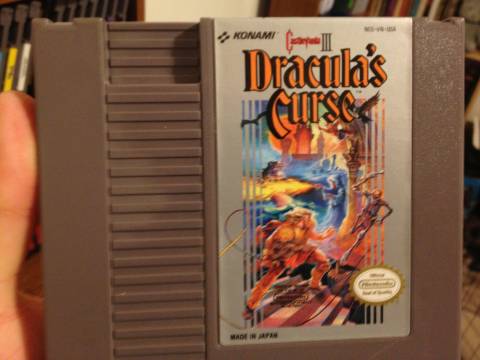
Castlevania III: Dracula's Curse
A little background
After Simon's Quest revealed that the fans did not want more of those types of Castlevania games (yet), Konami went back to basics with Castlevania III: Dracula's Curse in September of 1990. Castlevania 3 was a prequel to the first two games, playing as Simon's ancestor, Trevor, and starting the whole "there will always be a Dracula, a Belmont, and a Castle" triforce of rules that Bioshock Infinite clearly ripped off. Ok, maybe not, but the Belmont genealogical tree at least makes sense, unlike Zelda's chronology.
Anyway, Castlevania 3 brought back your regular, linear-style of whipping, though in this game you had a few branching paths as well as alternat characters. Grant could stab with knives and climb on walls and ceilings, Sylva was a magician nuker lady (though it says "he" joined your party after you get her. Lazy!), and Alucard's first appearance in the series was paired with the super-cheaty "bat transform," which could get you through most levels. This was the first time in the series you could switch between multiple characters in a single game, a feature abandoned all the way up until the DS's Portrait of Ruin.
First impressions last forever
This is another great looking, great sounding Castlevania game. From the badass opening scene where Trevor is praying before the cross before tossing his cloak behind him, ready to kick undead butt; this game feels awesome. The color pallet also feels like a fusion between Castlevania and Simon's Quest, with enough bright colors to make necessary things pop, but still having a dark underbelly. And the stained glass in the second screen is phenomenally gorgeous.
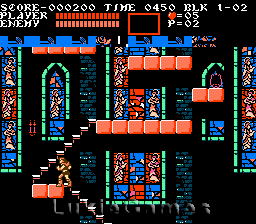
But as I played further...
This game is super hard, one of the hardest on the NES. And yeah, Castlevania wasn't exactly easy or anything, but it felt fair. Castlevania 3 is like Castlevania's sadistic brother, constantly torturing you with levels you know are possible, but why are they so hard? The staircase with the shooting skull heads that you can't even kill is probably the absolute worst, though there's still plenty more (jumping on moving pendulums with his awful jumping mechanic? Gee, thanks Konami).
This game also, while still feeling much tighter designed than Simon's Quest, still isn't quite as refined as Castlevania. There's a few weird screens and stages where stuff doesn't really feel like it's been put there intentionally, and whoever designed the exploding-jellyfish enemies should be punched in the face. Maybe it's the difficulty that exacerbates this feeling of somewhat tossed-together levels, but in either case it doesn't feel quite as fun or polished as Castlevania, though to be fair it does feel more polished than 99% of all other NES games.
So what's the conclusion?
Castlevania 3 is a sequel that played it safe, but also incorporated enough new stuff to be unique (the multiple characters and splitting paths). I would have considered this to be the best Castlevania game on the NES, if only they'd done a better job balancing the game and pacing its difficulty better. Instead, you get an uneven game that can be fun one minute, challenging the next, and hair-pullingly difficult the next. Now take those three and mix them up into a completely random order, and you have Castlevania III.
It's still a very fun game (though a Game Genie with unlimited lives helps), and you can get better at the game and memorize it's levels to eventually beat it. But the difficulty is so high it isn't nearly as satisfying as mastering the first game, which is a shame. Castlevania 3 is still essential to an NES collector's collection, but you'll probably play Castlevania 1 more.
Copies are getting pricy as well, usually around $15-30, depending on the quality of the label.
